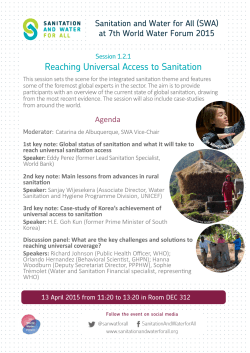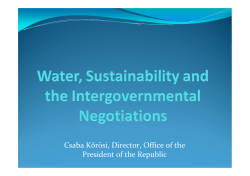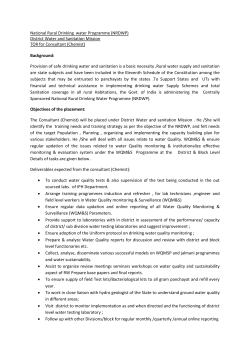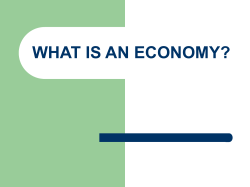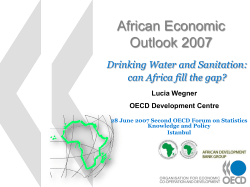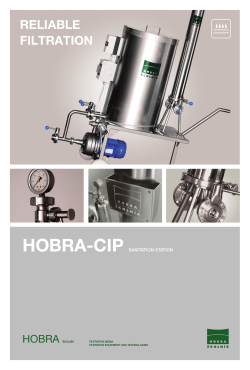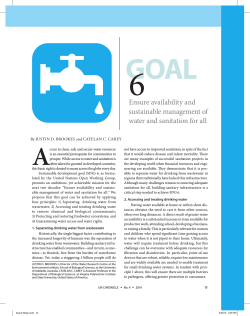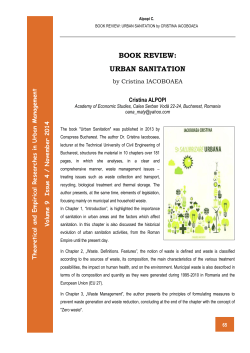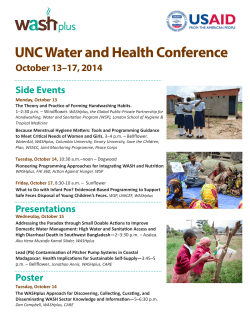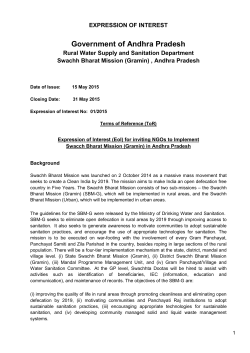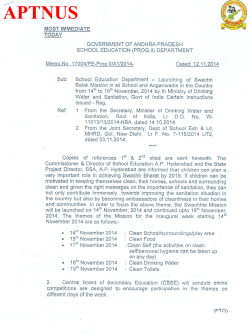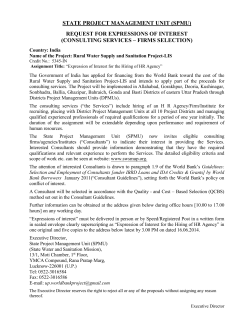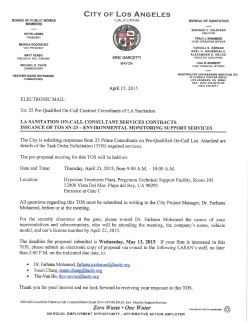
NGO Water and Sanitation - California YMCA Youth & Government
YMCA Youth & Government Model United Nations Forum on Non-Governmental Organizations TOPIC PREPARATION GUIDE NGO/15/TPG/2 Distr.: General March 2015 Original: English United Nations Development Programme (UNDP): Environmental Sustainability Access to Clean Water & Sanitation Section 1 Topic Background 1.1 Water scarcity has implications on the health and wellbeing of all citizens around the globe, even those who do not live in water-scarce nations. Around 1.1 billion people around the world have limited access to clean, purified water, and 2.4 billion people do not have access to any sanitation facility (i.e. a toilet or latrine).i Water is poorly managed, wasted and polluted, and the uneven distribution of this basic necessity proves to be a big problem in the international community. The Food and Agricultural Organization has estimated that by 2025, 800 million people will be living in countries or regions with absolute water scarcity, and two-thirds of the world population could be under stress conditions.ii In order to provide clean, fresh water, it is necessary for water resources to be easily affordable and available. If water is not adequately purified and distributed, individuals will be prone to diseases and illnesses. 1.2 The African region has experienced many difficulties in attaining the goal of improved access to water and sanitation facilities due to poor coordination, lack of resources, and misappropriated funding. Nigeria is one of the nations considered by WHO and UNICEF as “off-track” with respect to the UN Millennium Development Goal 7, which calls for environmental sustainability, including making water safe and accessible. With over 110 projects currently in place, it is imperative for the international community to ensure that these plans are carried out successfully to eradicate the poor quality of water.iii 1.3 India is one nation that requires more time to improve its water quality, and the pollution of water is evident due to the contamination by sewage and agricultural runoff.iv Disease is prevalent, due to the fact that more than 500 million people do not have access to a toilet or latrine. UNICEF is supporting India by researching water testing technology as well as other solutions to fixing contamination in order to promote better water purification methods. 1.4 Meanwhile, in Brazil, efforts to purify and distribute water evenly are progressing quickly. Between 1990 and 2012, the access to water improved from 68 to 79 percentv, however, the slum areas in Brazil continue to live daily without adequate distribution of clean water. Because of poor sanitation in these areas (i.e. lack of access to toilets or latrines), disease is spread rapidly, however Brazil is working towards improving water quality by providing NGO/15/TPG/2 both short-term solutions such as water filters, as well as long-term solutions such as improving pipelines and investing in rainwater collection. Section 2 Past International Action 2.1 The UN Millennium Development Goal number 7 calls for ensuring environmental sustainability by the year 2015, by responding to climate change, protecting endangered species, developing clean energy, and increasing access to sanitation facilities.vi The United Nations predicts that the number of people with access to purified drinking water was 6.1 billion in 2010, up by 2 billion since 1990.vii Millennium Development Goal 7 is in progress by the UN and supporting organizations, which are working towards building wells, improving pipes and access to water, and funding technology to purify water. Many developing nations are not on track with respect to this goal, and must gain support from the international community in order to obtain and use the proper resources. 2.2 UN Water is a United Nations body that addresses water-related movements to contribute to the achievement of the UN Millennium Development goals.viii UN Water is responsible for collecting information about water and sanitation measures in various regions, compiling reports to inform others on measures that can be taken to preserve and purify water, maintaining task forces, and planning World Day for Water to raise awareness regarding water, sanitation, and hygiene. 2.3 Charity Water is a non-governmental organization (NGO) dedicated to ensuring clean, safe drinking water to individuals in developing countries by collecting and allocating funds to build wells, as well as distributing water purification technologies to clean water before it is used. By expanding upon partnerships and donors, Charity Water has raised enough money to develop many solutions to improve water quality and collection. By funding rainwater catchments, filters, and wells, this organization has furthered progress with MDG 7. Section 3 Subtopic A: Preservation 3.1 The affordability and availability of water are challenges that many nations face today. With limited resources available, the issue of providing clean, accessible water continues to affect the international community through pollution, famine and disease. 3.2 How can the international community conserve existing water resources, and reduce the need to build new wells and facilities to collect more water? For nations that have limited funding, it is important to maximize the efficiency of existing resources. Well preservation and rainwater collecting services are ways to conserve water that already exists. 3.3 Due to the availability of technologies and appropriate resources, the vast majority of people in developed nations have access to improved water and sanitation facilities. The 2 NGO/15/TPG/2 conservation of water, however, seems to be a prevalent issue in developed nations. How can we improve the conservation of currently existing water? Subtopic B: Purification and Distribution 3.4 What are effective methods of purifying water in order to make it safe to use? Technology and innovations are advancing, with LifeStraws, iodine tablets, and portable sanitizing devices to aid in the purification of water. In what ways can we distribute water to all citizens and ensure that this basic necessity is not limited? 3.5 Because of limited funding and resources, developing nations contribute to the problem of poor water quality and distribution because of poor hygiene, inadequate sanitation facilities, and weak water sustainability plans. How can we provide appropriate resources to these nations in a cost-effective manner? Subtopic C: Sanitation Facilities 3.6 What are the barriers to improving access to sanitation facilities (i.e. toilets and latrines)? What are the costs of not having sanitation facilities? Do some people bear a higher cost when sanitation facilities are not available? 3.7 Many governments have plans and funding to increase people’s access to improved sanitation facilities, but studies show that even after households have built sanitation facilities for themselves, family members do not use the facilities. What are the barriers to encouraging continued use of these facilities? Section 4 Further Research 4.1 Guiding Questions • What measures has your nation taken to improve access to water and sanitation? • What are the primary methods that citizens of your nation use to purify water? • How can developing nations with limited resources provide their citizens with clean water? 4.2 Research Sources • Food and Agricultural Organization on Water Scarcity • World Water Council: How do we Ensure Clean Drinking Water for All? • World Health Organization on Water Sanitation and Health • UN Water • UN Water Terms of Reference • Charity Water • Water.org 3 NGO/15/TPG/2 i “Water supply, sanitation and hygiene development.” World Health Organization. http://www.who.int/water_sanitation_health/hygiene/en/ ii “Hot issues: water scarcity.” Food and Agricultural Organization. http://www.fao.org/nr/water/issues/scarcity.html Ukuedojor, Magdalene. “Nigeria: Adequate Drinking Water Still a Tall Dream in Nigeria.” allAfrica. http://allafrica.com/stories/201301070680.html iv “India.” Water.org. http://water.org/country/india/ v “WHO / UNICEF Joint Monitoring Programme (JMP) for Water Supply and Sanitation.” WHO-UNICEF. http://www.wssinfo.org/about-thejmp/introduction/ vi “Goal 7: Ensure Environmental Sustainability.” United Nations Millennium Development Goals. http://www.un.org/millenniumgoals/environ.shtml vii Wijesekera, Sanjay. “MDG drinking water target being met is cause for celebration.” The Guardian. March 6, 2012. http://www.guardian.co.uk/global-development/poverty-matters/2012/mar/06/mdg-drinking-water-target-met viii “Terms of Reference.” UN Water. http://www.unwater.org/downloads/UNW-terms-of-reference.pdf iii 4
© Copyright 2025
